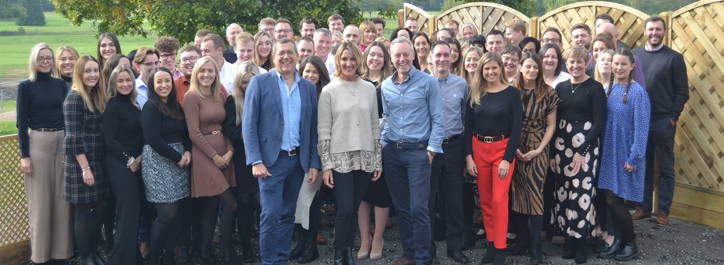Breaking the bias on International Women’s Day 2022
This year’s International Women’s Day theme is #BreakTheBias. Here’s how we’re embracing this, and how you too can break the bias in your own recruitment processes.
“Imagine a gender equal world. A world free of bias, stereotypes and discrimination. A world that’s diverse, equitable, and inclusive. A world where difference is valued and celebrated. Together we can forge women’s equality. Collectively we can all #BreakTheBias.
Celebrate women's achievement. Raise awareness against bias. Take action for equality.”
This is taken from the website of International Women’s Day, a global day dedicated to celebrating the social, economic, cultural and political achievements of women, and accelerating women’s equality. The idea of breaking the bias – giving a fair, unbiased service to all our clients and candidates, and creating a diverse and inclusive culture where our people can succeed and feel safe – is really important to us. In fact, it’s been a part of our culture and ethos since we started the business back in 2002.
It’s not just about doing the right thing, either. A report by management consulting firm McKinsey & Company called ‘Delivering through diversity’ showed that having a more diverse leadership team actually improves financial performance, and it gives companies a competitive advantage. So there really is every reason for actively recruiting for a diverse and inclusive workforce. Here are our tips for breaking the bias.
-
Eliminate unconscious bias
Unconscious bias is when we unintentionally favour someone because we believe they’re ‘like us’. Or we think less of them because they’re different to us, for example, because of their age, sex, race or religion. Doing this means we could inadvertently miss out on a great candidate.
We’ve trained all our consultants to recognise unconscious bias. So, we know that the best way to do this is to make people conscious of it in the first place. Training and education to raise awareness of what unconscious bias is and the impact it can have on recruitment, workplace culture and business success is the first step to getting rid of it completely. A quick and easy way to help with this is to get as many people as possible to review CVs, including those who’ll be on the same level as the person you’re hiring.
-
Create inclusive job adverts
When you’re writing a job advert or description, try to avoid using language that could stop anyone from applying. You might be surprised at the types of words that can do this. For example, lots of words commonly used in job descriptions can unconsciously be perceived as masculine, which could put a woman off from applying for a position. That’s words like ‘competitive’, ‘dynamic’ and ‘driven’. On the other hand, terms like ‘supportive’ and ‘collaborative’ are more associated with women and could make men think that a position isn’t for them.
Other things that can alienate women include having a long list of essential requirements. That’s because women only tend to apply for jobs if they meet every requirement, whereas men will apply even if they only meet some.
You should also steer clear of jargon or industry acronyms. These can exclude people from outside your industry, even if they have the skills and experience you want.
Before sending out a job description, read it again (or give it to a colleague to read) with unconscious bias in mind. Make sure the skills and experience you’re asking for really are essential – be clear on what’s vital and what’s a nice-to-have. Try to stay away from any overtly masculine or feminine adjectives. But if you must use them, make sure you’ve got an equal mix.
-
Introduce blind recruitment
Blind recruitment is when you remove certain information from job applications when you’re creating shortlists. So that could be age, gender, university name or any other identifying factor – even someone’s name can influence the way we think about them before we’ve met them (for example if we make an association with someone else with the same name who we like or dislike).
Obviously what information you exclude will depend on the type of role you’re recruiting for. But done well, blind recruiting can be a powerful tool in your arsenal when it comes to creating a more diverse shortlist.
-
Use a diverse hiring team
A large part of unconscious bias involves unintentionally being drawn to hiring people like ourselves. Making recruitment more of a team effort can help stop this. Try to make sure your interview panel is made up of a diverse team of people who all bring different perspectives – even having two people rather than just one can make a difference. It can also be really helpful to include colleagues who aren’t so invested in the appointment, for example from another part of the business.
If you do decide to make hiring a group effort, be aware of the potential for conformity bias. This is when people’s need to belong means they unconsciously follow the views of the majority of the team. Using interview scorecards where each person rates candidates on a numerical scale – without conferring, of course – is one way to avoid this (there’s more about this below).
-
Structure your interview process
Having a structured interview process that’s the same for all candidates will help you keep recruitment as fair as possible. Agree questions in advance and create a clear and objective scoring system for everyone in the recruitment process to follow.
Including competency-based interview questions can help you keep the focus on establishing whether a candidate has the experience you need. These types of questions move away from qualifications and industry experience, and encourage people to use real-life examples to show their skills. Competency-based questions are something our recruitment consultants are big fans of. Here are a few examples:
- ‘Tell me about a time you helped a member of your team who was struggling.’
- ‘What do you think makes you a good fit for our organisation?’
- ‘What was the last big decision you had to make at work?’
- ‘Give me an example of when you had to improvise to achieve a goal.’
While structured interviews can be a great way to keep bias at bay, don’t forget you still need to give interviewees the chance to shine. So don’t be scared to go off script if it’s beneficial to both of you. And remember that if an interview is too rigid or formulaic, you might even put prospective employees off.
-
Bring in an outside perspective
Working with an external recruitment agent could help stop bias in its tracks. Our consultants can take you through the whole process, including handling applications to create a shortlist for interviews. We can even sit in on interviews to bring in a new point of view.
Going the extra mile to #BreakTheBias
Our Women’s Leadership Programme helps women in business boost their confidence, develop leadership skills and build a professional network. We started the programme to help organisations develop inclusive workplace cultures, and overcome barriers that stop women from achieving their full potential.
We’re also always looking for ways to improve diversity and inclusion a bit closer to home. So we’re working with specialist diversity, equity and inclusion consultant and executive coach Katie Allen. She’s running a series of workshops on inclusion culture at Pure for all our team, helping to make sure we always value and celebrate ‘different’.
Need some help?
If you’re not sure where to start when it comes to building a more diverse workforce, we can help. Just get in touch to find out more.



